Welcome to the world of smart homes, where your living space adapts to your needs, anticipating actions and simplifying daily routines. If you’ve ever wondered “how smart home works,” you’re in the right place. A smart home system transforms an ordinary residence into a responsive, intelligent environment by integrating various devices and technologies that communicate with each other and can be controlled remotely. This guide will demystify the underlying principles of smart home technology, explaining everything from device communication protocols to the central role of smart home hubs and the power of home automation basics. As the global smart home market continues its rapid expansion, valued at USD 121.59 billion in 2024 and projected to reach USD 633.20 billion by 2032 with a Compound Annual Growth Rate (CAGR) of 23.1%, understanding this technology is becoming increasingly important for students and enthusiasts alike. [SOURCE_CITATION]
Key Takeaways
- A smart home is a residence equipped with internet-connected devices that can be controlled remotely and automate tasks.
- Smart homes operate through a network of devices, sensors, hubs, and communication protocols (like Wi-Fi, Zigbee, Z-Wave).
- The Internet of Things (IoT) is the foundation, enabling everyday objects to collect and exchange data.
- Benefits include enhanced convenience, energy efficiency, and improved home security.
- Smart home hubs act as the central brain, facilitating communication between disparate smart devices.
- Automation rules and voice assistants allow for hands-free control and personalized routines.
- Security and privacy are crucial considerations, requiring strong network practices.
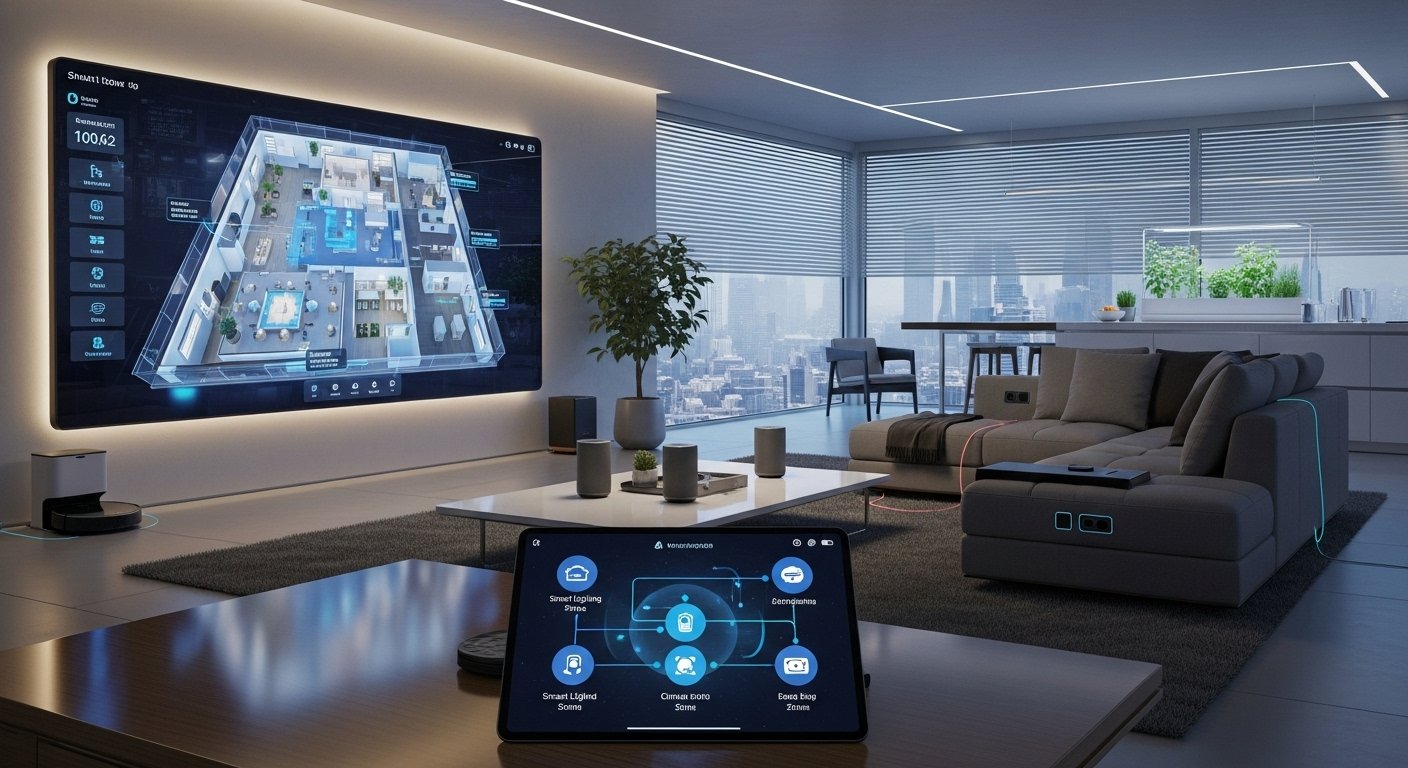
What is a Smart Home?
A smart home is essentially a residence that uses connected home technology to provide homeowners with security, comfort, convenience, and energy efficiency by allowing them to control smart devices, often via a smartphone app or another networked device. [20] Think of it as a house that can think, listen, and act based on your preferences and external factors. This encompasses a wide range of smart devices, from intelligent lighting systems and thermostats to advanced security cameras and voice assistants.
The concept is deeply rooted in the Internet of Things (IoT), which refers to the vast network of physical objects embedded with sensors, software, and other technologies for the purpose of connecting and exchanging data with other devices and systems over the internet or other communication networks. [1] These IoT devices how they work is by collecting data from their environment or user input, transmitting it, and then responding intelligently. With 63% of US households projected to have at least one smart home device in 2025, and U.S. households owning an average of 21 connected devices across 13 categories as of 2023, the ubiquity of this smart home ecosystem is undeniable. [SOURCE_CITATION, SOURCE_CITATION]
How Does Smart Home Work? Unpacking the Core Technology
Understanding how smart home works involves delving into several interconnected components that form the smart home architecture. At its heart, a smart home system relies on devices communicating, processing information, and executing commands, often without direct human intervention. This process involves a blend of hardware, software, and internet connectivity.
The Brain of the Operation: Smart Home Hubs and Controllers
Do smart homes require a hub? While some devices can connect directly to your Wi-Fi network, many comprehensive smart home systems benefit greatly from a Smart Home Hubs/Controllers. These devices, sometimes called gateways, act as the central control center, enabling disparate smart devices to communicate and respond to each other through a single point. 15] They translate signals between different communication protocols, effectively allowing devices from various manufacturers to work together within a unified smart home ecosystem. For students interested in setting up their own smart home, understanding these foundational components is key to building a robust and reliable system. You can learn more about essential smart home devices, including hubs, in our guide: [5 Must-Have Smart Home Devices for Beginners.
Speaking the Same Language: Communication Protocols
For smart devices to interact, they need a common language. These are known as smart home wireless protocols, and they dictate how smart devices communicate. Common protocols include:
- Wi-Fi: Widely used for devices requiring high bandwidth, like smart speakers and security cameras. It leverages your existing home network.
- Bluetooth: Ideal for short-range, direct device-to-device connections, often found in personal gadgets.
- Zigbee: An open-standard, low-power, wireless mesh network protocol. Devices form a mesh network, relaying signals to extend range and reliability. Zigbee operates in the 2.4 GHz band, which can sometimes contend with Wi-Fi signals. [10, 13]
- Z-Wave: A proprietary, low-power wireless mesh network protocol specifically designed for home automation. Z-Wave operates on a less crowded sub-1 GHz frequency, offering better penetration through walls and fewer interference issues than Zigbee. [10, 11, 14, 17] The Z-Wave vs Zigbee explained debate often highlights Z-Wave’s emphasis on interoperability across its certified devices, while Zigbee offers more flexibility for manufacturers. [11, 17]
These protocols ensure that commands from your smart home hub or app reach the correct device and that feedback from sensors is received.
Sensing the Environment: Sensors
Sensors are the “eyes” and “ears” of your smart home. These vital components detect changes in the environment and transmit this data. Examples include:
- Motion sensors: Detect movement, often used for security or automating lighting.
- Temperature sensors: Monitor room temperature, crucial for smart thermostats.
- Door/window sensors: Indicate whether an entry point is open or closed, enhancing security.
- Light sensors: Adjust lighting based on ambient light levels.
The Action Takers: Smart Devices and Actuators
Once a sensor detects an event or a command is issued, Smart Devices/Actuators carry out the requested action. What devices are in a smart home? This category includes the gadgets you interact with daily:
- Smart lights: Change brightness or color, or turn on/off remotely.
- Smart thermostats: Adjust heating and cooling, learning your preferences.
- Smart locks: Allow keyless entry and remote access control.
- Smart speakers and displays: Devices like Amazon Alexa and Google Assistant are highly common; in 2025, smart speakers were present in 72 million U.S. households, making them the most common smart home device. Smart TVs are also prevalent, found in 71% of connected homes. [SOURCE_CITATION]
- Smart appliances: Refrigerators, ovens, washing machines that can be controlled remotely.
The Digital Backbone: Cloud Services and Internet Connectivity
Most smart home technology relies on Cloud Services/Internet Connectivity. Data collected by devices is often sent to the cloud for processing, storage, and analysis. This enables remote control from anywhere in the world and allows for complex Automation Rules/Routines to be executed, even when you’re away. The internet connection is critical for seamless operation and for integrating services like voice control smart home features via Voice Assistants (e.g., Amazon Alexa, Google Assistant, Apple Siri).
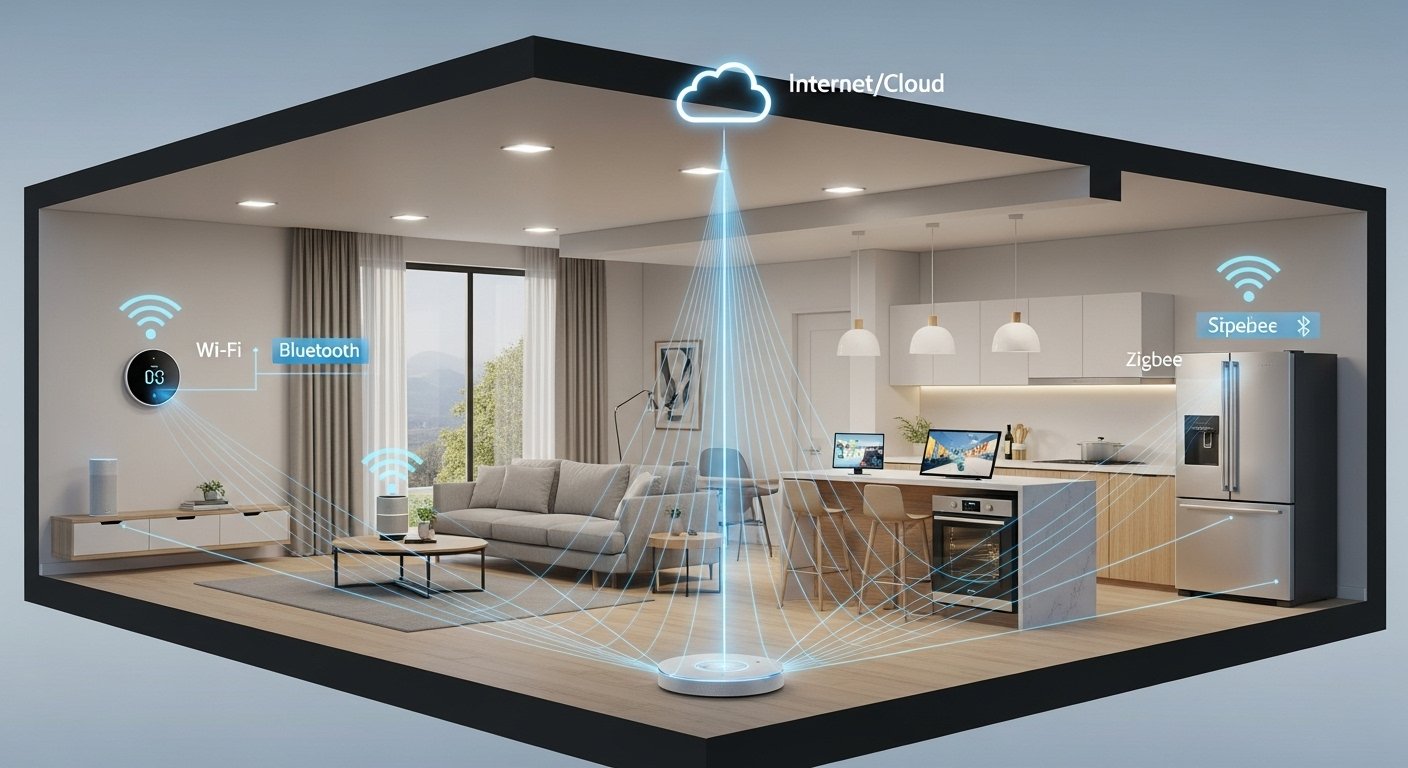
The Internet of Things (IoT) and Your Connected Home
As we’ve explored, the foundation of modern smart home technology is the Internet of Things (IoT). The IoT describes a network where everyday physical objects are embedded with sensors, software, and other technologies that allow them to connect and exchange data with other devices and systems over the internet. [3] This means that a wide array of devices, from your smart thermostat to your smart refrigerator, are constantly collecting data and communicating with each other and with cloud-based services. This constant exchange of information is precisely how IoT devices how they work to create a responsive and intelligent environment. The burgeoning smart home ecosystem is a prime example of IoT in action, where devices aren’t just standalone gadgets but components of a larger, interconnected system. On average, U.S. households owned 21 connected devices, covering 13 device categories, as of 2023, showcasing the extensive reach of IoT in our homes. [SOURCE_CITATION]
Home Automation Basics: Creating Your Smart Environment
Home automation basics involve setting up a system where devices can perform tasks automatically or on command. This is where the true intelligence of a smart home comes to life, allowing you to streamline tasks and enhance your living experience. If you’re asking, “How do you make your home smart?” the answer lies in understanding and implementing automation.
Automation Rules and Routines
The magic of automation often comes from Automation Rules/Routines, sometimes referred to as ‘If This, Then That’ (IFTTT) logic. These are pre-programmed conditions that trigger specific actions. For example:
- *If* the motion sensor detects movement after 10 PM, *then* turn on the hallway light to 20% brightness.
- *If* the temperature drops below 20°C, *then* turn on the smart thermostat to heat the room.
- *If* you leave home (detected via geofencing), *then* lock all smart locks and arm the security system.
These rules can be simple or complex, linking multiple devices and conditions to create a truly personalized experience. Learn more about unlocking automation in your home with our guide: Unlock Your Smart Home: A Beginner’s Guide to Automation.
Voice Control Smart Home with Virtual Assistants
Voice Assistants like Amazon Alexa, Google Assistant, and Apple Siri have revolutionized how we interact with our smart homes. By integrating with these assistants, you can control your entire smart home ecosystem using simple voice commands. This seamless interaction is a cornerstone of modern connected home technology, making control intuitive and accessible for everyone in the household.
Smart Home Network Setup and Architecture
Setting up a smart home involves planning your smart home network setup and understanding the overall smart home architecture. This typically includes:
1. Internet Router: Your home’s gateway to the internet.
2. Smart Home Hub (optional but recommended): Connects various smart devices, especially those using Zigbee or Z-Wave, to your home network and the internet.
3. Smart Devices: Individual devices connected directly to Wi-Fi or through the hub.
4. Smartphone/Tablet: Running smart home apps for control and monitoring.
While the goal is to make your home smart, the actual how to set up a smart home process involves ensuring all components are compatible and correctly configured to communicate effectively.
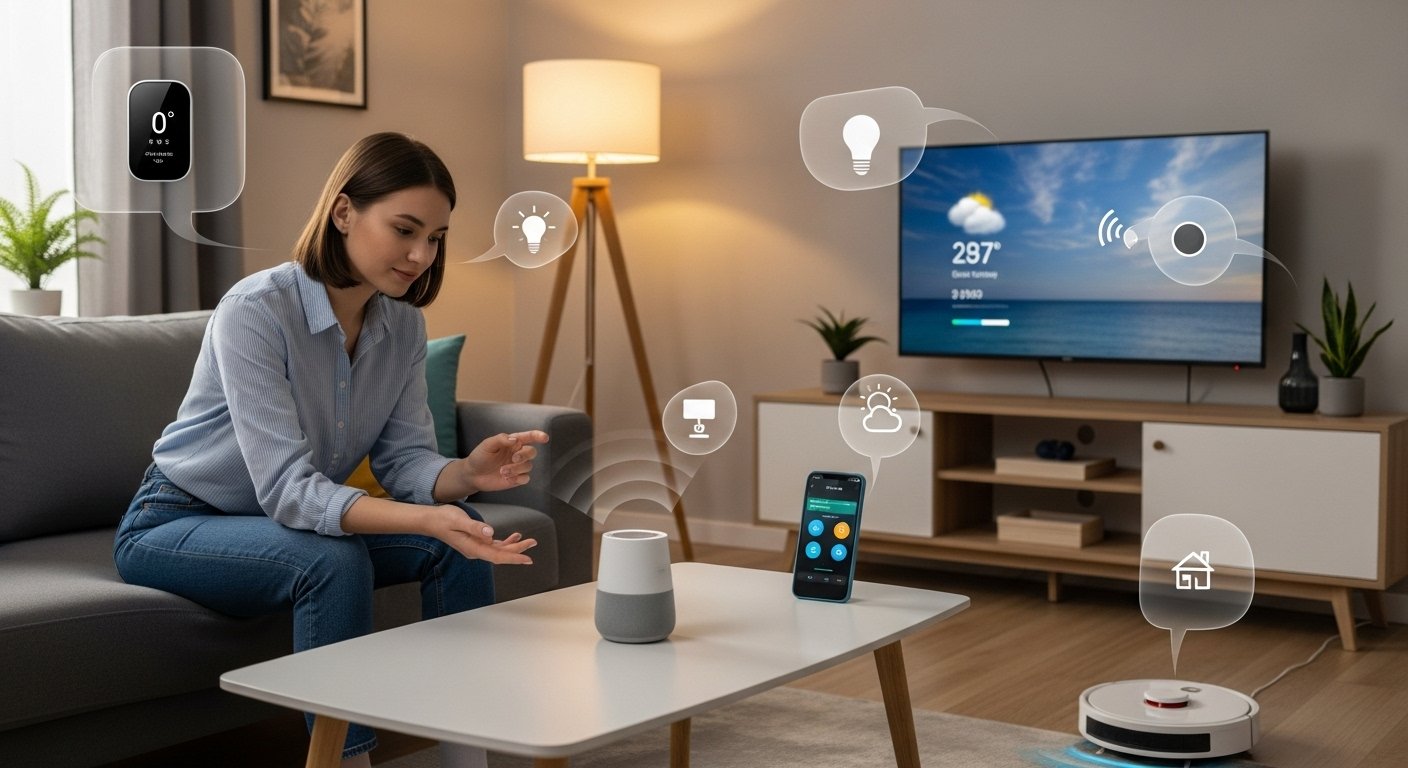
What Do Smart Homes Do? Benefits of a Connected Lifestyle
The advantages of adopting smart home technology explained are numerous, focusing on enhancing comfort, convenience, and efficiency. What do smart homes do to improve daily life? They provide a range of benefits that cater to modern living.
Enhanced Energy Efficiency
One of the most compelling reasons to adopt smart home devices is energy efficiency. According to recent data, 56% of global consumers cite energy efficiency as the top reason for adopting smart home devices. SOURCE_CITATION] Smart thermostats can learn your schedule and preferences, automatically adjusting temperatures to conserve energy when you’re away or asleep. Smart lighting systems can turn off lights in empty rooms or dim them based on natural light, significantly reducing electricity consumption. This not only benefits the environment but also leads to noticeable savings on utility bills. For deeper insights into this, refer to our guide on [Home Automation for Beginners: Smart Steps to a Connected Life.
Increased Security and Peace of Mind
Home security is another major area where smart homes excel. Smart locks allow you to lock or unlock doors remotely, grant temporary access to guests, and receive notifications about who enters and leaves your home. Smart security cameras offer live video feeds and motion-triggered recordings, while door and window sensors alert you to any unauthorized access. This comprehensive approach provides an unparalleled sense of security and peace of mind.
Ultimate Convenience and Comfort
Imagine waking up to lights gently brightening, your coffee brewing, and your favorite news briefing playing – all automatically. This is the convenience a smart home offers. Remote control allows you to manage devices from anywhere, while voice control smart home systems provide hands-free operation. Whether it’s adjusting the mood lighting, starting a robotic vacuum, or pre-heating the oven, smart devices simplify countless daily tasks, freeing up your time.
Accessibility and Support
Smart home technology also offers significant benefits for individuals with mobility challenges or specific needs. Voice control, automated routines, and remote access can make daily tasks easier and enhance independence, providing a more accessible living environment.
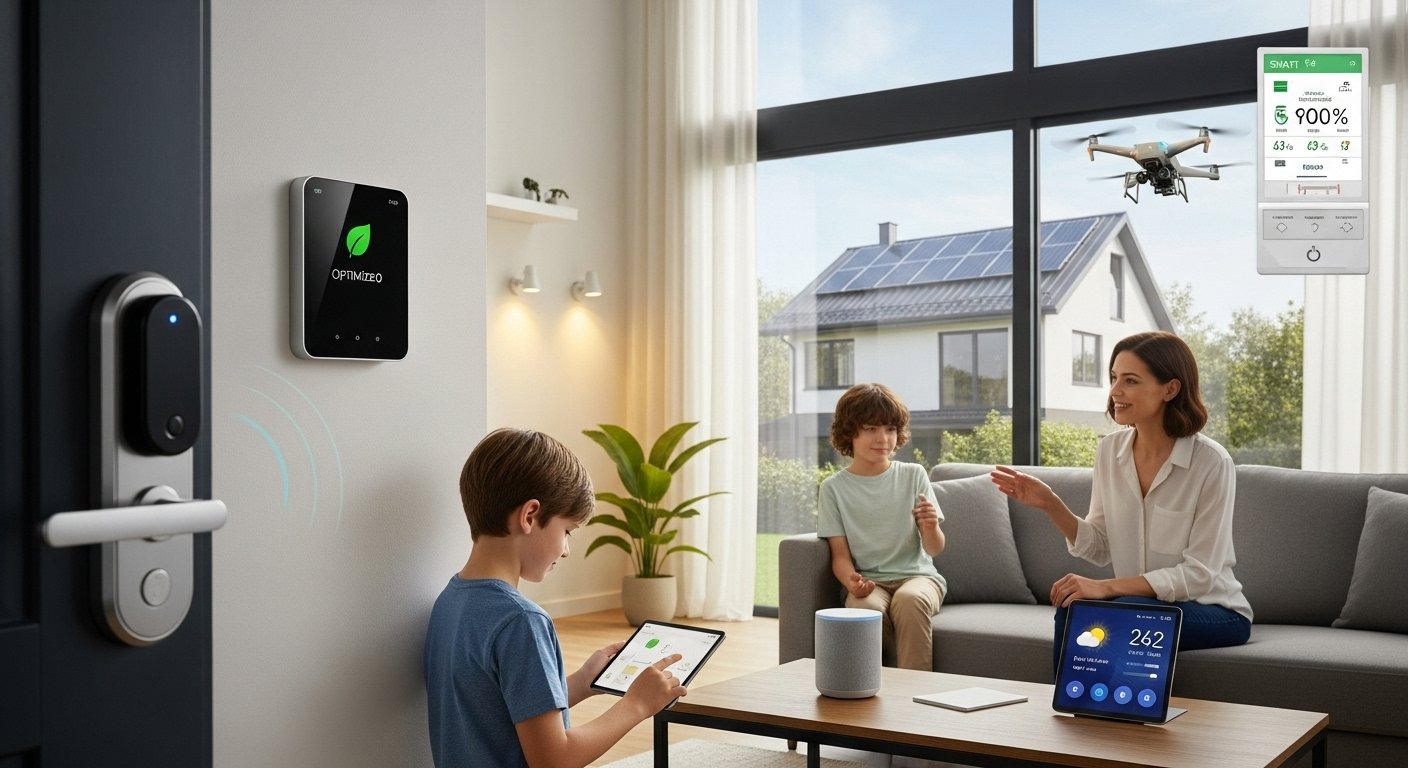
Addressing Concerns: Security and Privacy in Smart Homes
As with any connected technology, smart homes raise important questions about security and privacy. Ensuring the safety of your smart home network setup and personal data is paramount.
Can Smart Home Devices Be Hacked?
Yes, like any internet-connected device, smart home devices can be hacked if proper security measures are not in place. [19] Vulnerabilities can arise from weak passwords, unpatched software, or insecure network configurations. However, manufacturers are constantly improving security features, and users can take several proactive steps:
- Strong, Unique Passwords: Use complex passwords for all smart devices and your Wi-Fi network.
- Two-Factor Authentication (2FA): Enable 2FA whenever available for an extra layer of security.
- Regular Software Updates: Keep device firmware and apps updated to patch known vulnerabilities.
- Secure Wi-Fi Network: Use a strong encryption protocol (WPA3 or WPA2) and consider a guest network for visitors.
- Network Monitoring: Be aware of unusual activity on your network.
Understanding and implementing these practices is essential for safeguarding your connected home technology from potential threats. The National Institute of Standards and Technology (NIST) provides extensive guidance on IoT cybersecurity, emphasizing the importance of secure product development and risk management. [5, 8, 9, 12, 16]
Is a Smart Home Worth It? Evaluating the Value
Given the investment and considerations, many ask, “Is a smart home worth it?” The answer largely depends on individual needs, priorities, and budget. For those who value convenience, energy savings, and enhanced security, the benefits often outweigh the challenges. The ability to control your environment, receive real-time alerts, and automate mundane tasks can significantly improve quality of life.
The market trends indicate a strong positive outlook, with widespread adoption and continuous innovation. As smart home technology becomes more integrated and user-friendly, its value proposition continues to grow. For students contemplating a future with home automation, understanding how smart home works is not just about technology; it’s about envisioning a more efficient, comfortable, and secure way of living.
Conclusion
In conclusion, a smart home is more than just a collection of gadgets; it’s an intricate smart home ecosystem powered by the Internet of Things (IoT), designed to make your life easier and more efficient. By understanding how smart home works – from the foundational role of smart home hubs and diverse communication protocols like Z-Wave and Zigbee, to the intelligence of sensors and actuators – you can appreciate the true potential of home automation basics. The integration of voice control smart home features, coupled with the ability to create customized automation rules/routines, offers unparalleled convenience, energy savings, and enhanced security. As the technology continues to evolve, the connected home technology landscape promises even more innovative solutions for future living, making the smart home an increasingly integral part of our daily lives.
- Authoritative External Resources:
- Internet of Things – Wikipedia [1]
- Home Automation – Wikipedia [6]
- NIST: Internet of Things [5]
Frequently Asked Questions
What is a smart home?
A smart home is a residence equipped with internet-connected devices that allow for remote monitoring and management of systems like lighting, heating, security, and appliances, often controlled via a central hub or smartphone app. It leverages the Internet of Things (IoT) to create a more convenient, efficient, and secure living environment. [19, 20]
How do you make your home smart?
You make your home smart by integrating various smart devices, such as smart lights, thermostats, and locks, and connecting them through a central smart home hub or directly to your Wi-Fi network. Automation rules and routines can then be set up to control these devices, often using voice assistants or a dedicated app. [18]
What do smart homes do?
Smart homes provide benefits like enhanced convenience through remote and voice control, increased energy efficiency via automated climate and lighting adjustments, and improved security with smart locks, cameras, and sensors. They automate routine tasks and offer real-time monitoring and alerts. [19]
What devices are in a smart home?
Common smart home devices include smart lights, smart thermostats, smart locks, security cameras, video doorbells, smart speakers (like Amazon Alexa or Google Assistant), smart TVs, and smart appliances (e.g., refrigerators, washing machines). These devices often connect through a smart home hub. [19, 20]
Can smart home devices be hacked?
Yes, smart home devices can be vulnerable to hacking if security measures are inadequate. It’s crucial to use strong, unique passwords, enable two-factor authentication, regularly update device firmware, and secure your Wi-Fi network to minimize risks. [19]
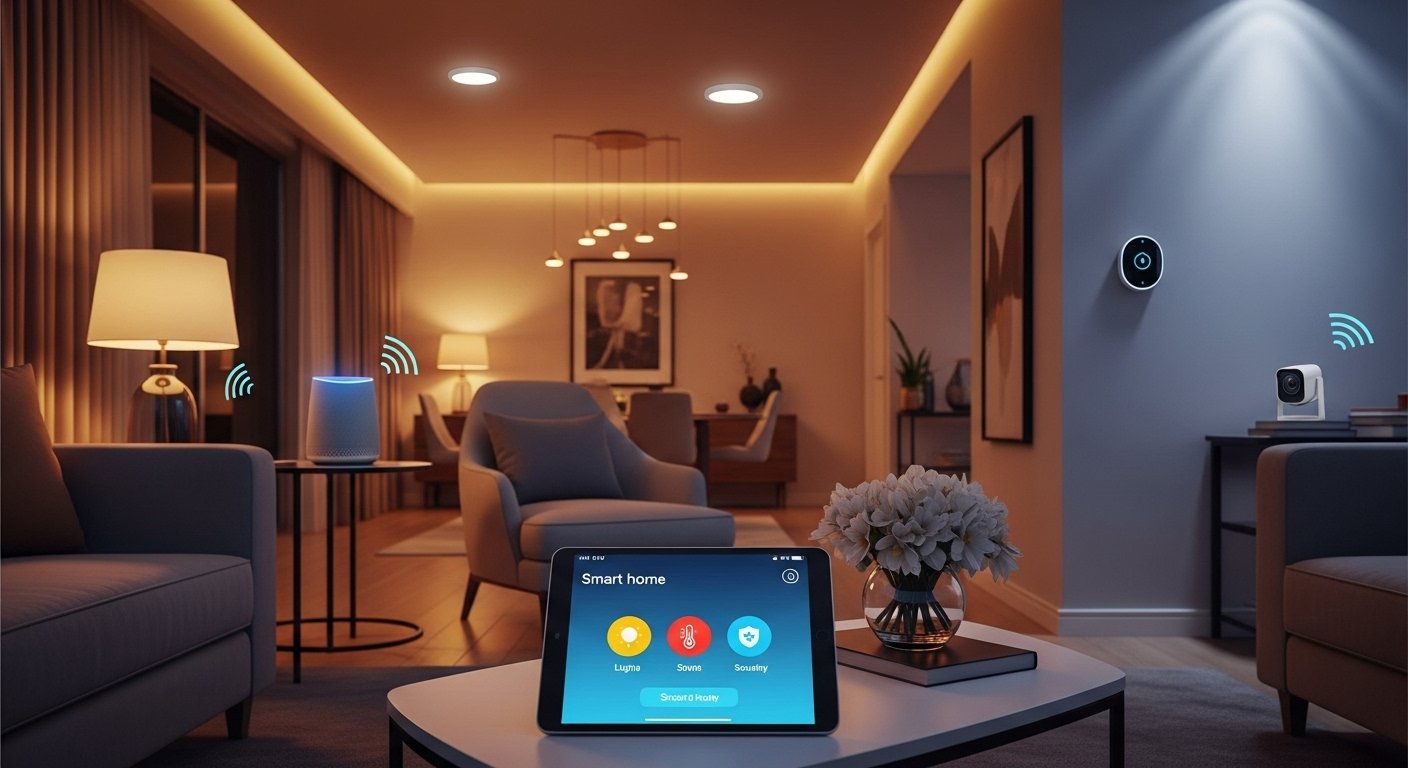
Leave a Reply